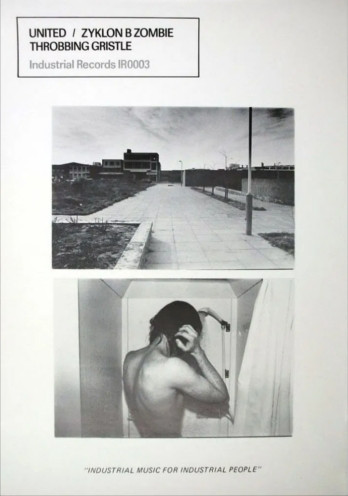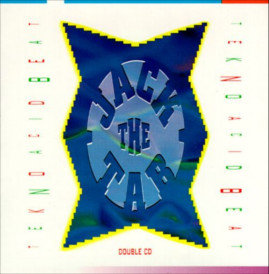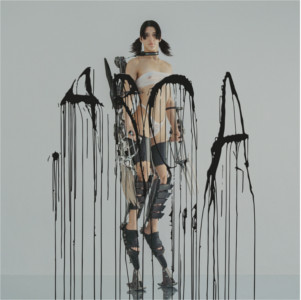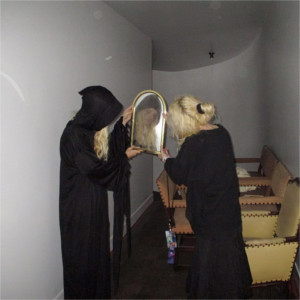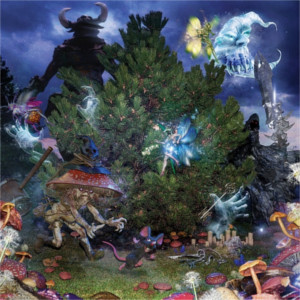A Sex Close to Noise0
An Essay about Transgender Women and Music
by Leah Tigers
“Industrial music for industrial people” was the tagline which sold Throbbing Gristle’s first 7’’ single, written on its flyers in all-cap italics below an eldritch photo of a faceless, sex-ambiguous body washing its long hair alone in a shower. So first listeners in 1978 might uncomfortably reflect, as I still do, “What is an industrial person? Am I industrial?”
Upon listening to “Zyklon B Zombie” (and its A-side “United,” in which two lovers lose their independent sexed identities to one another’s passion) the answer was obvious: an industrial person is completely unintelligible. If listeners could divine its lyrics, apparently sung by a contralto swordswallowing an air horn, they would hear from “a little Jewish girl” being led to gas chambers, only to have the perspective switch to a waffen-SS soldier, as though victim and abuser were the same horror. An industrial person is subversive, but not always in a liberatory way: TG’s lyricist, already then naming h/erself Genesis P-Orridge (the idiosyncratic pronouns would come more than a decade later), has since been credited by bandmate Cosey Fanni Tutti with a history of both abusive and self-destructive behavior.1 “The P stands for Pervert,” Gen informed a radio host in 1984, “and Piercing.” Piercing: by 1984 Throbbing Gristle had broken up, and the new song “The Orchids” by Gen’s next project Psychic TV may well be the first (only?) positive pop tune about genital modification.
When dreams made real become less sweet
The orchid and the metal
My sex turns and claws rush to spill them
But in the morning, after the night
I fall in love with the light
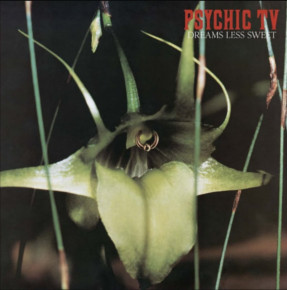
“We used to be much more aggressive in the old days,” Gen recalled of Throbbing Gristle. “Now what we like to do [in Psychic TV] is be seductive but actually still have a distasteful side.”
By 1993, Gen’s transgender identity had become self-evident through The Pandrogyne Project, a kind of awkward body theater whereby h/er identity merged alongside h/er late spouse, dominatrix Lady Jaye. In some sense Gen’s gender project is, like noise music generally, articulating a propensity towards the inarticulable. Rather than building a unified musical work (or physical body), all h/er artistic life Genesis has cited influence from the “cut-up” technique of William Burroughs, both of them piecing together lyrical propaganda from girly mags, chick tracts, obits on serial killers, the toxic waste of a verbal city. “I was a homosexual,” Burroughs wrote in Queer, “…simpering female impersonators… could it be possible I was one of those subhuman things?”2
I am not a female impersonator, nor am I a subhuman thing, but I have come to believe those of us who are called these are, for better or worse, industrial people.3 Often, we make industrial music.
To cite ourselves as industrial people is not to repetitively cite industrial music as our starting point. To order ourselves in history, industrial fanzine Toxic Grafity (1980) dismisses, would not be industrial at all: “Now we live in a technological, silicon chip society, and yet electronic music still looks backwards to blues and boogie for its references, it reveres history like symphony orchestra revere Mozart.” This analogy obscures; electronic music reveres even Mozart just fine. When electronic music composer Wendy Carlos4 released Switched-On Bach in 1968, her career was made. The cover of a man in a powdered wig sitting before a Moog synth module is deplorable cyborg kitsch. It is the best-selling classical record of all time.
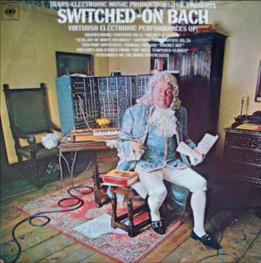
Wendy was incredulous at her debut success. She recalled in a 1999 retrospective, “It’s nice to have demonstrated – which was all it was – that the medium [of electronic music] is far more flexible and capable than one might be aware.” In her liner notes to its 1992 update, she called the work “infamous,” and later compared it to an actor being typecast. “I was certainly not about any revival of Bach.” Imagine having your entire artistic career defined by a proof-of-concept.
This astonishing professional success was a personal disaster. In multiple interviews, filmed and live, Wendy dragged to maintain her public persona as a man, with pasted-on sideburns and brow pencil filling her pores as five o’clock shadow. In this she broadly failed; there was gossip she was a woman pretending to be male to advance her career, which hit the nail on the head, if not in the precise manner such gossipers intended. In 1979 she announced herself as transsexual in an interview for Playboy.
“I’ve got to be careful not to attack my background as being wholly destructive,” she spoke, “[those years in the closet] might have encouraged my work – my escape into the world of thought and music and science and technology.” Those years were also, she labeled, Hell.
Hell is a persistent background of Wendy’s music. I mean this literally; her song “Clockwork Black” off of Tales of Heaven and Hell (1998) begins with a “Hell Chant”: “We are all in Hell; we are the dammed!” From the liner notes, “A trip through Hades will contain sadism and things that go bump in the night… This is music of a large, populous city.” Of course there is Heaven too; this is her precision, her logical clarity, her own humble attempts at sensemaking. But it was her unintended affinity for the scary, dark new age, the falling-apart of digital technology, which employed her nearer to industrial culture, scoring famous soundtracks for hacker flick Tron and hypersex dystopia A Clockwork Orange.
The synthesizer, especially circa 1968, is conceptually hellish. When we pick up a guitar, a piano, a drum kit, we have already begun music; each instrument has inherent form restricting content. Elimination silently precedes composition. Wendy’s Moog synthesizer had no sonic form; soundwaves are manufactured as if from nothing, and the field of the instrument is pure noise. She decides the timbre, picks the tone, designs the scale. To master sound design above instrumentation is, I believe, an invert’s choice.
This is my primary and substantial appreciation for Wendy Carlos. My mental picture of her is of a woman – a spinster, to use the mean word – in a quaint townhouse littered with hostile and unforgiving machines (and, her website tells me, three cats). Yet unlike established urban hoarders, the Collyer brothers, the Beale women, William Burroughs in a literary frame, Genesis P-Orridge in a musical one, for whom atrocious mess has an indefinite logic which belongs to them alone, Wendy rescues form from trash for the sake of giving it her audience. Studio recording becomes pointillism; “stream-of-consciousness” is a vanquished term in her art. Every soundform must be deliberately modeled, each overtone in a series determined and meticulously added in to a note by hand. What happens in Switched-On Bach is like an arrow of melody shot out of static. Its fundamental interest to me is the risk of catastrophic failure that demands, that all will collapse back into darkness, Hell, the beast, pure noise.5
The thrill of this digital risk is greatest in Beauty in the Beast, Wendy’s “most important album,” by which she means her deepest and most personal. This is her closest work to pure noise, because it is microtonal, yet it is noise tightly regulated by a series of specific microtonal tunings of her own invention, possible only on a digital synthesizer. “Everything about Beauty was too novel,” she wrote, “People are usually fearful of what is unfamiliar.”
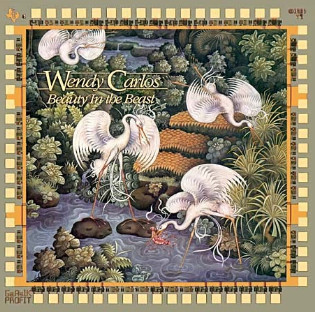
This peculiarly modern anxiety between tradition and individual talent6 is just as demonstrable in classical music, if not moreso, as it is in any other genre. Classical composers were the first noise musicians – there was no other genre of composer to be. The theremin was invented by a Soviet music professor. The ondes martenot was developed by a French cellist. The earliest “noise-makers” (intonarumori) were made by the son of a church organist. Historians have analyzed all as predecessors to the synthesizer. These were sounds from alien cityscapes.
In 1913 the inventor of these noise-makers, Luigi Russolo, sent out his manifesto The Art of Noises, in which he announced a specifically modern conception of noise as music. “We are approaching noise-sound,” he wrote, “This revolution of music is paralleled by the increasing proliferation of machinery.” This was to be a “new futurist style, the orchestra of a great battle.” “In a few years, the engines of our industrial cities will be skillfully tuned so that every factory is turned into an intoxicating orchestra of noises.” Russolo’s most refined noise composition, Awakening of a City, sounds as the world to a rat nesting in a taxicab engine. Luigi was not a loveable character; his optimist philosophy of noise came alongside an embrace of the absolute worst aspects of the industrial city: apathy toward abuse, approval of warfare, and constant flirtation with fascism.7
Writing in 1939, Walter Benjamin was able to more critically discern these failures of urban living, and serve as a more moral prophet for the dangers of fascist politics. “Inhospitable, blind age of big-scale industrialism” to Walter was the primal site of modern trauma.8 He refers to the newspaper, so integral to the abstracted lyricism9 of Burroughs and Genesis, as evidence.
If it were the intention of the press to have the reader assimilate the information it supplies as part of their own experience, it would not achieve its purpose. But its intention is just the opposite, and it is achieved: to isolate what happens from the realm in which it could affect the experience of the reader.
The city experience is here an experience of shock, in which perpetual streams of sensation disorient its inhabitants until they can no longer register experience, and therefore cannot form memory. Walter does not mince words. This is “time in hell, the province of those who are not allowed to complete anything they have started.” In hell and the big-city, correspondences within and between things (like those of, say, sex, gender, and the body) break down entirely. In this view, the self-proclaimed perversions of Burroughs or Genesis look more like blithe submission to capitalism than its subversion; it is Wendy Carlos, able to cultivate meaning from noise, who has developed meaningful novelty. She does so through processing trauma, in the most literally instrumental sense.
Queers collect in Benjamin’s big-city. We are initially traumatized by alienation from regular family, which pressures us into continued abuse. Walter suggests by way of masculinist myth how city life might render our women alien: “Female satyrs and nymphs are no longer members of the family of man. Theirs is a world apart… When such eyes come alive, it is with the self-protective wariness of a wild animal hunting for prey. (Thus the eye of the prostitute scrutinizing the passers-by is at the same time on its guard against the police.)”
“The ‘realism’ of the prostitute,” as critic John Berger phrased it, came to replace the broken ideal of the female nude in urban life. Sex workers were “the quintessential woman of early avant-garde twentieth-century painting.” Walter refers to this supposed realism, the immediacy of a body undefined by its history, as “the disintegration of aura.” Goodbye feminine mystique!10 In his modern city bodies have no proper names.
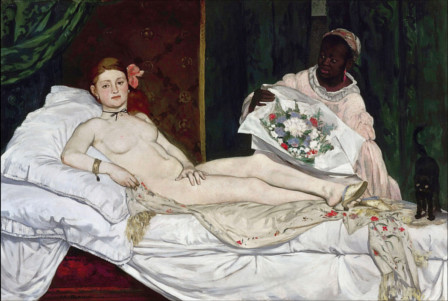
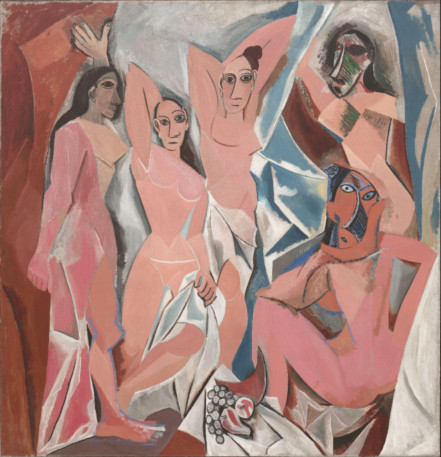
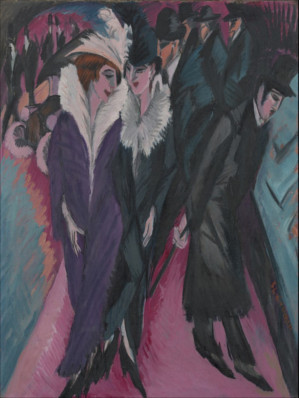
This particular commentary on sex workers can be extended to trans women practically without qualification.11 Many of us sell sex.
Holly Woodlawn sold sex. She was transgender, she was real, she was called prostitute, and she became urban, fleeing an abusive family with a company of gay boys to live as a teenage dropout on the streets of New York. She met Candy Darling – who also sold sex, probably – in 1963, followed a few years later by Jackie Curtis, whose was raised by a mother and grandmother selling sex, probably. Lack of stable biographies replaced their lack of aura. All were transgender women in their particular way.12
This was Real New York, or billed as such, made from those after-dark hours, the kind of lowlife nocturnal femininity Burroughs and many other talented men made their names describing.13 In 1967, Jackie impressed herself upon the painter Andy Warhol on his way to a boutique designer clothing store, and the three girls began to ingratiate themselves in his infamous, exploitative, and literally industrial Art Factory.
The Factory was the studio where Andy made his slick, silk-screen, mechanically reproduced, outrageously expensive prints. It was also Andy’s loosely curated personal scene, a kind of uplifted seediness from which artists, almost always male artists, could pick off vibes and to a lesser extent be part of. Lou Reed was a classic case. In 1975, just a year before he went single and declared “no more faggot junkie trip,”14 Lou was queer-married to a trans woman, Rachel Humphreys. (He never had it in him to produce actual faggot energy, like with a man.) That year he released Metal Machine Music, a double album of guitar feedback, as an act of artistic self-destruction, a final send-off to his old art fag persona. This writer is of the rare opinion its noise is his best solo material, but his more popular tune “Coney Island Baby” ends with a dedication to Rachel, and his most famous song, “Walk on the Wild Side,” is a final judgment of his days spent with Factory dolls Holly, Candy, and Jackie.
Holly came from Miami, F.L.A. |
Candy came from out on the Island |
Jackie is just speeding away |
She says, "Hey, babe, |
In the era of noise, trans and sex-working women became the postmodern muse. Rather than summoning classical knowledge to the mind of the male artist, we wisked it away. Lou used us to pretend he was wild, not traditional; Andy imagined us commodifying sex the way he commodified art. When these men surveyed what deconstruction they had wrought, they did become horrified, and all their attempts to rediscover meaning outside context led them back to lazy conservatism. Lou was an edgelord of the most basic order: casual misogynist, anti-Semitic Jew, serial abuser, lightweight racist, and most especially transmisogynist. Lazing about on his bed with a male peer Andy stuttered, “These drag queens… they don’t really know what girls go through. I mean they’ve never had a period. They’ve never had a period. They can’t really tell.”15 These men were our champions.
Paul Morrissey, who directed the dolls throughout their famous Warhol-produced pictures, was a boringly straightforward antifeminist Catholic rightwinger. On the plot of his film Women in Revolt (in production less subtly titled Revolting Women): “It seemed to me a funny idea that men who had devoted their life to assuming the roles of women should be asked to play women who are told by the Women’s Lib movement that they should assume the roles of men.” The idea of transfeminism is the superlative joke to Paul; he filmed as a joke, as noisily as possible, with no script, in order to jeer at trannies on-screen.
Candy is the only true actress; she was a starlet, but she tried too much. Holly’s character is gross and sexy because Holly was gross and sexy. Jackie dominates the film because she thinks fastest. She could improv stunningly; when, in the film, the women discuss their experience of sexual violence in a consciousness-raising group, one speaks of being abused by a Hell’s Angel. “I was gonna tell him where his place was –” she starts. Jackie, without missing a beat: “And where was his place, Betty?” “In his house,” Betty errs, to have Jackie feed her the line, “In Hell.” “In Hell! Yes! That’s right! It was just like Hell!”
“Jackie was a feminist,” Warhol superstar Penny Arcade recalled. Unlike Candy or Holly, Jackie had been reared by a single mother and grandmother (who, again, probably sold sex). It was Jackie who demanded Andy be on set to film some of Women in Revolt, because, director Paul Morrissey recalled, “[Andy] wasn’t a person who had creative ideas.” He would simply turn the camera on and let the dolls speak.
Holly and Candy were diarists, but Jackie Curtis was the writer. She wrote plays for Holly and Candy to star in. Unlike Andy Warhol, Lou Reed, or Paul Morrissey, her art has not been canonized, which is a shame because it is better. Jackie’s Glamor, Glory, and Gold is a kind of off-off-Broadway Sunset Boulevard, in which aging actress Nola Noonan, who is obviously a stand-in for Jackie, spirals out as performed reality destroys her fantasized stardom. To achieve this stardom Nola believes she must learn to perfectly pronounce her “T’s,” an entirely meaningless gesture which has her strutting around the stage for the duration of the play tuttering a senseless beat, “T… t… t… t…”
The surreal comedy of gab is the lifeblood of Jackie’s playwriting. Her next play, Heaven Grand in Amber Orbit, is pastiche, cutting up lines from artifacts of pop culture: lyrics of one-hit wonders, old TV Guide magazines, a diner menu, the movie All About Eve. Seemingly every character speaks nonsense and has had a sex change. This is ironic comedy, a comedy derived from desensitization to pain. That pain is clear: “I was raped at an early age… seven,” Nola proclaims. “I’m emotionally insecure, I always feel undressed and scared, but if I could feel undressed and not scared – maybe it would start paying off!” To me, Jackie’s contribution within the subculture of ‘60s queer experimental theater was the beginning of transgender femmes carving out a specific position within city noise as victims, rather than noise’s traditional obfuscation of victim and abuser. Nola’s first film proposal: “SEARCH FOR A DEAD NYMPHO: a grippin’ tale of a demented transvestite.” Nola’s film director berates her: “You no longer amuse anybody… you’re fucking repulsive! Do you know what I means to be fucking repulsive? You are gonna suffer, Nola.”
This is a comedy of industry. Nola stutters because, it is quipped, as a child her tongue got caught in a Chinese typewriter; “Inhuman cameras… Machines without mercy,” she names in her ending monologue, as all that which won’t remain in the starry heaven she is (yet again) setting out in search of.16 “I left you all saying my ‘t’s’ like a pro.”
At the time of Jackie’s Nola-esque death by heroin overdose in 1985, noise in music had split trajectories in a profound way. The pop art manufactured in Warhol’s Factory revealed that utter meaninglessness could, in fact, be tremendously popular – or rather, popularity was meaning, the scene was the music, the medium the message. The industrial music genre found rhythm and audience in hybrid genres like electro-industrial and electronic body music; its mind-numbing mechanic blather of pure noise was replaced by the mind-numbing mechanic repetition of the 4/4 drum machine. Genesis P-Orridge’s industrial Psychic TV project released a series of fake mix compilations, such as Tekno Acid Beat, occasionally credited as the first ever acid house record. This was noise for the masses, not against them. It really was made by those ignominious and alienated noise musicians, yet, it really was playing in the clubs.
“The Techno scene and, at that time, the Dance Music scene was way more influenced by Industrial Music and Detroit Techno than anything else,” Jordana LeSesne said in interview. Music mags put her on their lists of Best American Drum ‘n’ Bass Producers, or Women in Black Music History You Should Know; in 2000 she was subject to a transphobic hate crime from a stranger. Since then her public presence has been violently reduced. Decades after the jungle craze she pioneered in the States, Jordana is still “starting to slowly get my life back together,” which has included the release of new music far more political, personal, and direct than before.
“People ask, ‘why is the recent music you’ve made so much harder, darker than the stuff you did in the 1990s,’” Jordana recorded on Twitter, “the anger, depression and pain makes me almost want to not answer. the truth ‘because my life itself has been harder and darker than it was in the 90s.’” Of that bygone era, Jordana recalled, “For many years [before transition], I was immersing myself in the music and scene as a means of escape. The distorted drums, the aggression, it was like a microscope into my state of mind at the time.” “I was going to Raves17 to get away from the sort of bleak existence I had.”
The Club offered transgender noise a center in Blackness, and continues as one of its clearest venues today. This is most explicit to me in the crisp, stark, and sensual sound designs of Lotic: “I’ve always had a love for noise music and for noisy music. Loud chanting, distortion — always gives music a bit more life for me”; “I always want to remind people that I’m black and gay, and that I’m here to reclaim club music and club culture from corny straight white dudes.” On her trans identity, Lotic first said, “Maybe! What’s wrong with that?” Since that time her trans identity has taken on fuller shape. Her music endeavors to bring people together; a deep and unspoken erotics distinguishes her from the sexless and clinical European house she is sometimes associated with. She says the best circumstance to hear her music is “in a crowded room, with the doors locked and lights turned off”: The Club.
The renovation of trans noise in The Club is, if not most explicit, most popular and accessible in Juliana Huxtable. On being yet another pomo muse in the New York queer art scene, Juliana rolled her eyes: “It makes my skin boil.” Juliana gets marketed as an eternal go-between, a kind of central marginalization upsetting every marginal category she is assumed to represent, all of them sexualized: Black, trans, intersex, woman. On her digital spaces – an old Tumblr, a current Twitter – she types in ALL CAPS, a style which is notoriously more noticeable but less readable, to me evoking the typography of old industrial music agitprop. On moving to New York City she found “nightlife was really welcoming. It was a space that was diverse… a space for experimentation.” With that mindset she began to DJ: “Every set is an experiment”; “I like the risk of cross-pollination.” Her latest sets out of a more isolated experience in Berlin are, to my ears, her noisiest yet.
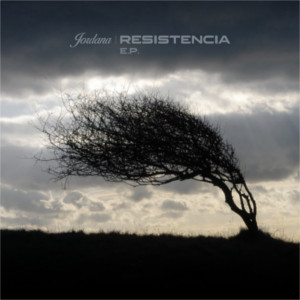

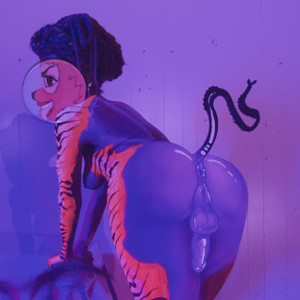
Through her organizing of numerous women-run nightlife parties, Juliana uses The Beat to cultivate space that fuses, brings gender minorities together, even if only in a temporary sense. Trans noise in the club or on the ballroom is often a more direct solution to the desolation motivating our presence in hipster noise performance art collectives of the late 70s. Noisy genres are not always as disparate as we’d suppose; “I was in a punk band,” club DJ Jordana LeSesne noted, “But they said I played more metal.”
The Mosh Pit of metal has become the other great contemporary scene of physical contact with transgender noise; it is our most controversial, in that we often oppose the violence which defines moshing entirely. In the past 15 years metal of a particular kind has achieved a relative prominence of trans women musicians and listeners. Life of Agony, Cretin, HIRS Collective, Jade Starr, and Danica Roem are all examples. The kind of metal trans women produce has been specified in the writings of Liturgy (whose frontwoman, Hunter Hunt-Hendrix,19 came out as transgender earlier this year). She wrote of “the feminization and queering of metal” as “basically a culturally illegal zone”; “I will always seek to occupy this.”
Hunter stumbled through multiple interviews (while closeted) of her “problematic relationship to black metal”: “There were these murders. The murder of a gay man… I don’t want to kill anybody or burn a church… to be honest all the time about my problematic relationship to black metal is my response to these gestures.” In a mass of extremely obscure and idiosyncractic theory, she specified that the classic creation myth of black metal was murder: “of Euronymous by Varg Vikernes,” two members of the early Norwegian black metal scene, in 1993. An alternate creation myth for her black metal was suicide: “of Dead,” a member of the band Mayhem, in 1991.
For her self-professed antitraditionalism, extreme awkwardness, and profoundly earnest pretension within the insular black metal genre, Hunter became a polarizing figure. “My personal experience of subjectivity is so feminine,” she said, “and given metal is such a male-dominated genre, a lot of people who hear the music are men who have repressed a certain capacity for tenderness. They hear Liturgy… and are motivated to call me a faggot.”
In trans noise the experience of violence turns inward. Abuser and victim are not confused except in the impulse toward suicide, where they are the same.20 “Originally, my attraction to black metal was congruent with the desire for suicide,” Hunter wrote. It then became a positive project, “to create a life-affirming black metal that would prevent me from killing myself.” In this I see our noisy musical project as essentially parallel to cis women metal artists and noise musicians who also are genre inverts, making victimization and experience of the body in pain the center of their work. My favorites today are Lingua Ignota and Pharmakon. Uboa, a trans woman, demands mention as well. More thoroughly than almost any other noisemaker, she slides under and across metal into pure noise, music for headphones.
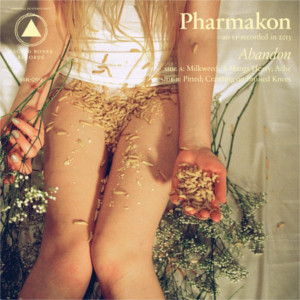

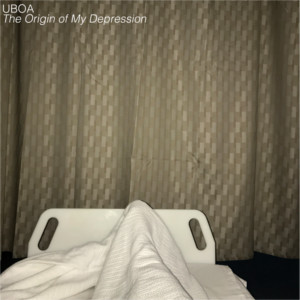
The Bedroom is the next great setting of transgender noise. It is our commonest. “For a lot of trans girls who I know,” Sep from noise band SBSM recorded in interview, “and as much, I know, for myself, our private spaces, like bedrooms, are such necessary realms for recuperating from the shit we take from the world.” Bedrooms are where sex happens; they are intimate, the cities in our heads, the theater of alienation before it is authenticated in a collective place. Its artists are nearly always singular people, not bands, perhaps not even musicians. “My world isn’t very peopled,” Uboa said in one her few interviews; “My version of womanhood is too singular… yet I am a real woman nonetheless.” Today the internet is spoiled with trans women and associated gender freaks making sounds closer to digital static than thrash guitar. The list is too long, but in the vein interest of completeness: There are countless others. Often they collaborate.
Bedroom noise can be poppy, make it big, and even sound great live, but the extent to which its textures are motivated by personal pathology typically dooms it to cult status, at best. A few such best cases require citation.
Black Dresses were a noise pop duo for three short years 2017-20 whose music, especially on their debut album, regarded first-hand experience of child sexual abuse. Their vocals lilt and burst like a borderline personality. Sonically, the tunes would be more danceable if they didn’t hurt. Lyrics throughout their discography make life after abuse increasingly legible. They are frightening in the sense they give to desensitized living: “You think you could handle feeling this every day? / Yeah I’m so cute and scared and small / but I’m not FUCKING OKAY. / Can you make me disappear? / Words don’t exist for this kind of fear.” Black Dresses broke up shortly after forming, due to online harassment surrounding one of the duo’s accounts of her experience of assault.
Lauren Bousfield is a glitched out high tempo earbreaker of an artist distinguished within the category by her extremely high level of production quality. Instrumentals are given almost bathetic titles (“Child Protective Services Theme Song,” “Foster Care Kid Running Away Again,” “If We Save Just One Child It Will All Be Worth It”) suggesting tremendous violence, usually against children, as a routinized, administrative occurrence. In the odd case songs have lyrics, they are typically so chopped in the mix that fans of Lauren’s earliest work as Nero’s Day in Disneyland have never been able to transcribe them correctly. It is as if its experience cannot be represented clearly. Later songs, correctly transcribed, explain this indirection directly: “Lay in bed and cry so hard you have to put your hand over your mouth”; “A supervised nightmare… Maybe I deserved it / I love shutting people out now… I love silence now / Just listening intently / Never look directly at the viewer.”
When a bedroom artist seeks a career in music, she will typically turn to production, as Wendy Carlos did. Lauren has worked soundtracking video games and score assistant on wide release films. Trans theorist Sandy Stone moved from esoteric “feral art” to gold-certified sound engineering for Van Morrison, Crosby Stills & Nash, and Jimi Hendrix. Nonbinary sound designer Arca’s stunning solo work has been relatively overlooked in favor of her production on albums from Björk, FKA Twigs, Frank Ocean, and Kanye West, perhaps because many of her own songs are in Spanish or she is otherwise simply too weird. But here we begin movement towards the final setting of trans noise, its most novel, popular, and surprising: The Radio.
The Radio (a metaphor for all music distribution venues, including the streaming service) is a surprising location for trans femme noisemakers because it means we can become the world’s beloved. We have arrived. We have recordings which are listened to by many people everywhere. It is not pure noise, which is far too alienating, but it is pop music distilled by noise, pop that cuts, pop hard as nails, the kind of thing snooty critics call “post-pop”21 because noise, the threat trans women carry, will always symbolize the death of genre.22 But there never were genres. Not truly. We tend to that. If we do not tend to it, critics say we do.
“Pop,” Laura Les of the band 100 Gecs described her genre when asked by an interviewer. “Woah so wacky! Pop.” She and her bandmate Dylan then riffed on goofy labels, “Electronic Banger Music,” “Electronic Pop Punk,” “Electronic Tech House.” “All music is the fucking same,” she laughed. She and Dylan trade off improvising stories whenever interviewers ask where their band name came from (street graffiti, a typo in a online retail order, an esoteric internet meme). What actually matters is that 100 Gecs writes bangers and people like them. Lyrics are casual and sometimes girly: smoking weed, loving your boyfriend, or (weirdly) losing money gambling at horse races. Their songs feel random, highly variant excepting core principles of danceability, distortion, and refusing boredom. Their constant use of vocoders, autotune, and voice-shifting make the aural fact of Laura Les’s transness irrelevant. 100 Gecs is perfectly clippable, easily shareable, rarely pleasant but difficult to ignore. They have opened for BROCKHAMPTON, played on Cartoon Network, and garnered over six million YouTube views. Critics like them too.
We could propose, as their acclaimers do, that 100 Gecs has nothing comparable in pop. This disservices pop. Charli XCX was herself a feature on 100 Gec’s “Ringtone (Remix).” She has become a pop icon who exploded by way of PC Music, a UK art collective which loans her songs a distinctive if often copied production. If there remains noise here, it is less like static than a marble falling down stairs, sharp, shimmering, never fit right to a beat. “Bubblegum bass,” “avant pop,” “hyperpop,”23 and (as ever) “post-pop” are the common labels for the style. Producer A.G. Cook gave Charli more of a bedroom white noise gloss on singles like “Forever,” but her work on 2016’s Vroom Vroom EP with producer SOPHIE (all caps!) proved to be some of the most divisive work in pop. Squeaks from a rusted hamster wheel seem to sound off the background on every song; the underlying percussion is always doing extra. Online comments are littered with the sentiment, “This is what old people imagine modern pop sounds like.” This is what modern pop sounds like.
“Genre is a stupid question anyway,” SOPHIE commented in one of her first interviews after coming out as trans. Previously she had kept her identity and appearance largely secret, but “I’m all about visibility now.” As a kid growing up in Glasgow, SOPHIE’s dad brought her old rave cassettes of the kind of acid house Psychic TV was producing at the time. After that her world became unpeopled, and she expressed an early desire to be a pop producer. It was always sound design she favored, even preferring to build a waveform – as Wendy Carlos had – rather than sample. She speaks about both transness and electronic music as a kind of process honesty, where integrity is less about fidelity to source material (if any there be) than about simply not lying. “I’m real when I shop my face” is the infamous line from her song “Faceshopping.” In an utterly surreal joint interview with a robot, also named Sophia, SOPHIE is asked the purpose of music: “Sending and receiving vibrations” is her answer. When SOPHIE asks Sophia the robot what celebrity she would be, Sophia cannot answer, saying that being a human would be overwhelming before returning the question. SOPHIE answers immediately: “Oh! Sophia the robot. I would be Sophia the robot.”
Today SOPHIE’s world has been repeopled. “I get so much energy and I learn so much from collaborating with people.” She has worked with Madonna, Charli, Vince Staples, and Kim Petras, the first Anglo trans teen pop idol. Kim is not in the end more noisy than our greatest ‘90s pop stars, yet it is possible to hear, especially in her collaborations with SOPHIE, that her songs are just slightly more of a razor than your average pop radio. SOPHIE is excited to work with Juliana Huxtable. Her & Cook’s PC Music collective have remixed 100 Gecs, who themselves featured Charli XCX on a remix.
It is difficult not to read these forms of social organization around noisemaking, in their many fluid and diverse forms, as trans women having an affinity. I have meant to present this affinity and speculate about its relationships to our world only as one of any number of useful frameworks for reckoning with the art and music trans women make. I have deliberately sought to stretch the framework to its breaking point. Many of our artists escape it because they simply do not fit. Others escape it because my own classed taste leads me to ignorance. For instance, Backxwash, a Zambian rapper whose music lies somewhere on the border between industrial noise and literal witchcraft, simultaneously fits a pattern while avoiding clear placement within the confines of this essay. “I miss going to noise shows,” she tweeted four months into the COVID-19 pandemic. It is striking in general how relatively little widespread notoriety trans women of color’s music has found so far; Backxwash, again, has thankfully broken this trend somewhat upon her deserved shortlisting for the 2020 Polaris Music Prize.
When a specific demographic of noise can be described as I have attempted, through a half-century history in songstressing, it appears we are no longer dealing with noise but with music proper. Yet I do not think even our most celebrated trans noisemakers have fully sacrificed noise; I do not believe we have deeply assimilated, nor can I maintain we are still rejected. Rather, I would like to finally suggest that the given distinction of noise against music, among others, has become increasingly outmoded as trans women have described and redescribed our own experience. Instead we design permutations, built out of the contradiction:24 sounds to move you, sounds to alienate you, sounds to be with you in your alienation, sounds which loan you recognition and recognition’s power.
To see noise as a trans woman and develop it into song, an album, a career, a scene, many scenes, and finally a history begins with the labor of articulating your own condition. Many parts of this condition will be and become shared. Through what is shared we become legible to culture. Broad affinities such as the one I have set out here to describe are, by definition, not universal; they are not felt by everyone and are not felt exclusively by anyone. Yet they can be powerful, powerfully spiritual, if only in letting us know we are not alone in our isolation. Perhaps we never were.
□
0Thanks are in order to some preliminary readers of this essay, my friends Theda (@tom4tmr), Ilya (@ilyaislost), and Lauren (@laurenbousfield).
1Tutti, Cosey Fanni. Art Sex Music. Faber & Faber, 2017. Chpt 4: “Gen came flying through the door wielding a nine-inch knife with ‘KILL’ burned into the wooden handle, blazing, staring eyes, screaming and heading for me”; Chpt. 2: “Gen hated and refused to wear condoms, and I foolishly went along with it”; Chpt. 4: “Suddenly there was a great thud at my side. I sprang up to see that a large cement breeze block had landed about six inches from my head. I looked behind me to see where it had come from. Gen had thrown it.” I am not split about the meaning of Cosey’s descriptions; Gen was an abuser. Cosey chose to disclose in a specifically commercial literary context where Gen must narratively act by her as villain in all respects, not only for being abusive but also for being transgender.
2I first learned about this quote and the short novel by William Burroughs from Rani Baker in Faggot as a Gender Identity, Detransition As A Form Of Suicide.
3Some words should be spared on why this essay specifies trans women. Of trans men, practically, simply neither the noise artists nor noise following are there; most trans men make quite different music. At present trans male musical aesthetics are more acoustic, generally, and fit to genre more easily. Trans male triumph narratives are much more common. (Examples: Ryan Cassata - Daughter, Skylar Kergil - Tell Me a Story.) My speculation is that because gender is hierarchical, trans masculine narratives more easily fit a pattern of ascension, self-pride, and trauma processing. Attempts to broadcast any such speculations fail immediately upon realizing trans people of different assigned sexes make music together. (On the nonbinary side of things it is the desirable case that some assigned female people have been taken as trans women and friends in this essay. Enjoy guessing which.) Of cis women or women generally, a quality attempt to describe “the privileged relationship between women, technology, and noise” absent transsexuality is Nina Power’s essay “Woman Machines: the Future of Female Noise.” However, noise is not a culturally dominant productive mode for cis women (or cis men) as it is for trans women; most cis artists are stably genrified. Within female noise, Pink Noises: Women on Electronic Music and Sound edited by Tara Rodgers goes so far as to attribute the notoriously trans-exclusionary Michigan Womyn’s Music Festival as “the training ground for an early generation of women sound engineers,” overlooking the work of trans woman Sandy Stone for Olivia Records in that same time period. None of its citations, as far as I know, are from trans female musicians; none of its interviewees are, as far as I know, trans women, though several have trans female relatives producing noisy music; several more have minor associations with Wendy Carlos.
4I suspect Wendy Carlos would not appreciate her inclusion in this essay. She is an intriguing and in many ways deliberately mysterious figure. She seems, to paraphrase Susan Stryker, to wish society understood transsexuality as unexceptionally and unculturally as we view left-handedness, and so I suspect she would not appreciate being included in this essay, which groups trans people together culturally. This is especially true because Wendy’s grouping here is solely thematic or metaphysical; she has never been in physical music-making community with other trans women as far as I know. I only hope that, in almost exclusively quoting from her own website site and album liner notes, she would agree I have treated her more respectfully than most other writers.
5There are a variety of writings about digital failure and the so-called postdigital age which should be understood as part of the heritage of this essay. Kim Cascone’s The Aesthetics of Failure is most prominent. Cox, Christoph, and Daniel Warner, eds. Audio Culture, Revised Edition: Readings in Modern Music. Bloomsbury Publishing USA, 2017 contains many more.
6A reference to T.S. Eliot’s famous essay of the same name. My thoughts are distinct from Thomas’s but the tension between artist and cultural (dis)inheritance is the central tension of this essay.
7The connection between Italian futurism and fascism is most obvious in Filippo Marinetti, author of both Futurist Manifesto and Fascist Manifesto. From Chessa, Luciano. Luigi Russolo, Futurist: noise, visual arts, and the occult. Univ of California Press, 2012, pg. 8: “Russolo’s documented involvement with fascism has until now been erased from Russolo scholarship; his participation in the Duce-endorsed futurist exhibit at Turin’s Quadriennale in May 1927 has been thoroughly suppressed, as has his involvement with the exhibit at Milan’s Pesaro Gallery in October 1929.” Industrial music, including Throbbing Gristle, also made troubling citations of occult, fascist, and Nazi iconography, though these were at least more ironic.
8Walter’s essay On Some Motifs in Baudelaire is a foundational paper in trauma studies. Reading Ann Cvetkovich’s Archive of Feelings: Trauma, Sexuality, and Lesbian Public Cultures (2003) introduced this element of spiritual Marxism into this essay.
9From the first paragraph of On Some Motifs in Baudelaire: “The lyric poet has ceased to represent the poet per se. He is no longer a ‘minstrel,’ as Lamartine still was; he has become the representative of a genre.” The trouble of being lyrical, for a trans woman, is that much of culture reads our deepest expressions of femaleness as illegitimate. We are therefore some of the deepest spiritual victims of capital, and at home in urban environments of shock Walter describes. His critique of capitalism sometimes overlaps with aesthetic conservatism; not living with digital technologies, I suspect Walter could not foresee the synthesis whereby lyrical articulations of industrial shock lead to the retirement of genre itself.
10 A reference to Betty Friedan’s The Feminine Mystique. Use of the word “mystique” is slightly unfortunate. Betty was referring not to mysteriousness, but to the allure gender role fulfillment (“love, home, children”) had over some women who then remained broadly unsatisfied fulfilling it. Urban life offered women different forms of accomplishment; to trans women, for whom Betty’s “love, home, children” was never possible, cities allowed us to simply not perish.
11Trans women have deep ties to sex workers but are of course not the same collectivity. However, I believe the symbolic value we held in male artists’ minds during the modern period was largely the same. From Sophie Lewis’s SERF ‘n’ TERF: “My observation is that those of us who beg to differ from prevalent ascriptions of our own gender, or who sell or have sold sex, denaturalise a concept of the human body to which many people have a wounded attachment – even if they profess to be combating it.” Comparing Sophie’s statement to Walter Benjamin’s “the melancholy man sees the earth revert to a mere state of nature,” we can see that which is natural and that which is cultural becomes dialectically confused for one another. Transness tears through this distinction.
12Candy Darling was deeply transsexual (“I’m too female to be half and half.”) Holly Woodlawn was out to have a good time, obviously a trans woman but didn’t much care about legitimacy. (“We wanted to be women, so bad!”) Jackie Curtis had the most inscrutable gender to me. I use feminine pronouns in the main article for consistency; masculine pronouns were used much of his life, by many of his friends, as long as they were not transsexual (although such basic transphobia was virtually universal at that time). He didn’t mess around much with hormones, had sex exclusively with men but did not consider himself gay, was a real “I’m just Jackie” type. He seems to have detransitioned and retransitioned multiple times. (“Thought she was James Dean for a day” as Lou Reed’s lyric goes.) At the same time, her stream-of-consciousness Heaven Grand in Amber Orbit, largely incoherent and mostly written while high on amphetamines, is positively obsessed with sex change surgery. I suspect, to say it straight, in a more supportive environment she would have been much more fluently genderqueer, and also probably not died from a heroin overdose. I am happy for their life as it was.
13Canonical books about seedy urban underworlds which include trans women are written by men: Hubert Selby Jr., John Rechy, William Burroughs, etc. My relationship to these works is complex. They are good and see things that need to be seen. They knowingly work by marketing themselves as transgression, when this transgression has in important ways not been experienced by the authors. This feels exploitative. Most trans women simply are transgressive (in important ways gay male writers are not). Most trans women do not pursue transgression. As a result most trans women writers write quite different books.
14This quote is passed around routinely. Several sources indicate it is from a 1976 Lenny Kaye interview in NME. I have been unable to verify it further.
15I learned about this quote from Willow Maclay’s Lust, Caution series retrospective on Women in Revolt for Vague Visages magazine. I did not link to this above because the article is now under paywall.
16This quotation is from Craig Highberger’s eBook collection of Jackie’s plays. It was written out in Craig’s recording of Jackie’s own performance for the play’s 1974 revival. Many thanks are in order for the amazing work Craig has done in preserving the legacy of the Warhol dolls.
17A large number of writings (many now quite rare) speculatively connecting rave culture to noise, bleakness, post-Fordian capitalism, and related concepts can be found in the writings of the Cybernetic Culture Research Unit and its hangers-on. I have not been able to get my hands on Howard Slater’s Break/Flow, which appears most relevant. Mark Fisher’s piece Goldie, Japan, Tricky from Ghosts of My Life: Writings on Depression, Hauntology, and Lost Futures is most accessible: “Jungle was by no means an unequivocal celebration of the urban. If Jungle celebrated anything, it was the lure of the dark.”
18 [Note: This footnote belongs to a piece of supplemental media.] For the album art shown below, I have opted to use Jordana’s SoundCloud cover for her Resistencia EP, as the original 1.8.7 song has no clear unique cover I know of. Juliana’s Flughafen set is ripped from a live video, and so has no album art either. I have used a crop of her painting Untitled (2018). Another crop was itself used by Juliana as the SoundCloud cover of her Undecided (Fact Mix 106).
19Hunter Hunt-Hendrix is a very interesting though not necessarily compelling figure in metal discourse. I find her endearing. She is, in my opinion, both idiolectic and graphomaniac, albeit as relatively minor cases. Her family is also extremely wealthy; many metal fans are poor. Some metal communities’ criticisms of her have been valid; most have been extremely vitriolic, masculinist, violent, and expose many of the exact flaws she is willing to call attention to from within the genre. And, simply, her band’s music is often quite good. I focus on her because, despite often being extremely verbose and esoteric, she has written and theorized herself and her music exponentially more than any other trans metal artist. I do not mean Hunter’s assertions to speak for all trans women in metal.
20I am playing fast to make a controversial point. I do not believe you can get far into thinking seriously about ideation without deconstructing selfhood. Proper theories of violence will account for external social forces which pressure people into suicide as a kind of murder-by-proxy, and will not consider suicide without duress violence, or suicide, at all. The theoretical possibility and limits of these suicide-forms is an open question to me. But in suicide with violence the relationship between abuser and victim is invariably a confused one, and that confusion is part of ideation’s profound agony.
21Stereogum notes SOPHIE’s “penchant for metallic post-pop alternate reality hits.” SOPHIE’s fandom wiki calls her “Post Industrial.” Brooklyn Vegan refers to PC Music as a “UK post-pop collective.” Spin’s review of the Vroom Vroom EP refers to the “unpredictability, elasticity, and sporadic abrasiveness of Sophie’s post-pop soundscapes.” The list does go on.
22Expectations around “genre” here should be understood with respect to genre studies, in particular Derrida, Jacques (trans. Avital Ronell). “The Law of Genre.” Critical Inquiry 7.1 (1980): 55-81. I draw attention to Jacques’s essay because of his almost singular dedication to inducing genrelessness and connecting “genre” to “gender,” its cognate: “We will not be barred from thinking that this mixing of genres, viewed in light of the madness of sexual difference, may bear some relation to the mixing of literary genres. ‘I,’ then, can keep alive the chance of being a female or of changing sex. His transsexuality permits him, in a more than metaphorical and transferential way, to engender.” Jacques does not respect transness as anything more than border occupation; in actuality permission to engender is least granted to transsexuals. But I nonetheless think Jacques’s involutions here have something serious to say about the difficulties of a trans female music, as it also creates some for us. Also relevant are essays in Noise and Capitalism, ed. Anthony Iles & Mattin, particularly “Genre is Obsolete” by Ray Brassier. The collection is strikingly absent transsexuality except for the following passage from Ray: “Oneiric depictions of psychic abjection in which organic and inorganic forms are subjected to cancerous metamorphoses. A transsexual Mickey Mouse sporting disfigured genitalia sprawls in pornographic abandon.” I agree this is one image men fascinated by transgression present transsexual women of transsexual women.
23The insolence and skepticism with which I regard the label “hyperpop” should be extended to “hypergender,” a term sometimes used by gender theory academics (who are not trans women) and sociologists (who are not trans women) and cultural anthropologists (who are not trans women) to name transfeminine and/or sex worker beauty aesthetics.
24Philosophical readers may recognize the movement of this conclusion, from music/noise to sound design, or sound designs, as a movement of thought from Hegelian or Marxist to Deleuzian, or from dialectic to rhizomatic. This recognition is just one potential.
